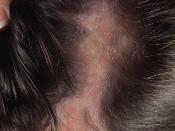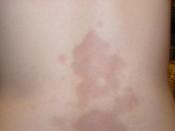Scleroderma is a word derived from the Greek language from the two words "sclerosis" which means hardness and "derma" which means skin, so Scleroderma literally means hardness of skin. Scleroderma, or systemic sclerosis, is a chronic connective tissue disease generally classified as one of the autoimmune rheumatic diseases. Scleroderma is a disease most people do not know about. I personally have had a lot of knowledge of this disease. My great aunt died of scleroderma my senior year of high school. She had been battling the disease for about 15 years and in the last year of her life it really started to take over her body. This paper is all about the disease and what it does to your body and what people with the disease can do to pro-long their lives.
Scleroderma is not just a single disease; it is a symptom of a group of diseases that involve the abnormal growth of connective tissue, which supports the skin and internal organs.
In some forms of scleroderma, hard, tight skin is the extent of this abnormal process. In other forms, like the form of scleroderma my aunt had, the problem goes much deeper, affecting blood vessels and internal organs, such as the heart, lungs, and kidneys.
Scleroderma is a rheumatic and a connective tissue disease. Rheumatic disease is a group of conditions characterized by inflammation and/or pain in the muscles, joints, or fibrous tissue. A connective tissue disease is one that affects the major substances in the skin, tendons, and bones.
There are two different classes of scleroderma that are then put into five subclasses. This is a chart of the types of classes of scleroderma:
Localized scleroderma is limited to the skin and related tissues and, in some cases, the muscle below. Internal organs are not affected...


